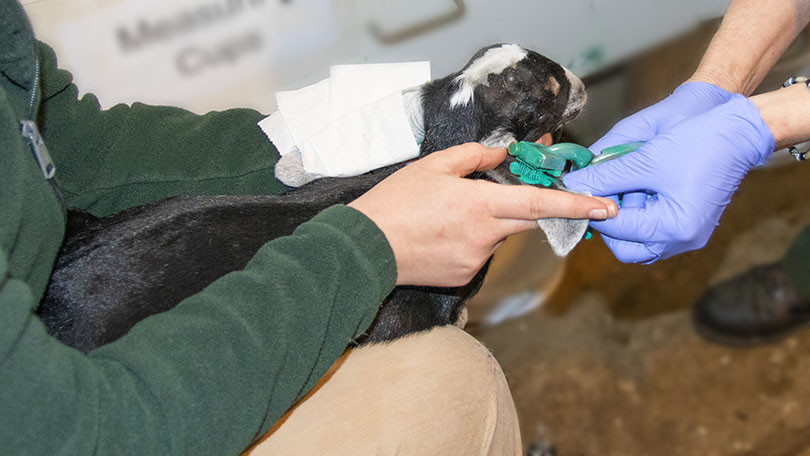For dairy goat enthusiasts and breeders registered with the American Dairy Goat Association (ADGA), tattooing is not just a practice—it’s a mandatory requirement. Before your goats can be officially recognized in the ADGA herd books, each one must bear a permanent tattoo. This guide will walk you through the essentials of goat tattooing, focusing on the use of letters for identification, ensuring your herd meets ADGA standards and best practices.
Why Tattoo Dairy Goats? ADGA’s Identification Requirement
The American Dairy Goat Association mandates tattooing as a primary method of identification for all registered dairy goats. This ensures accurate record-keeping and traceability within the dairy goat industry. Tattoos serve as a permanent identifier for each animal, crucial for registration, milk production records, participation in linear appraisal programs, and showing. Think of it as a goat’s unique social security number within the ADGA system.
Decoding Your Goat’s Tattoo: Herd Identification Letters
Every ADGA member is assigned a unique tattoo sequence, which includes letters specific to their membership. This assigned tattoo must be used on every goat born into your herd. This herd-identifying tattoo is placed in the goat’s right ear, right tail, or center tail. It’s crucial to remember a few key rules for this tattoo:
- Maximum characters: You can use up to four letters and/or numerals.
- Letter-number restrictions: Tattoos cannot start with a single letter followed by a number (e.g., avoid combinations like “K2” or “D347”).
- Assigned sequence only: You must use your assigned tattoo sequence. Using another member’s tattoo is prohibited.
If you apply for ADGA membership without requesting a specific tattoo, ADGA will assign one for you. Should you find the assigned tattoo unsuitable, you have a 30-day window to request a change free of charge. Remember, this assigned tattoo is for herd identification and goes in the right ear or tail. Tattooing animals before they are sold or purchased is highly recommended to maintain clear records.
Individual Goat Identification: Birth Year Letters and Serial Numbers
Beyond herd identification, ADGA also recommends a system for individual goat identification, using letters to denote the year of birth. This individual ID tattoo is placed in the left ear, left tail, or center tail. The system works as follows:
- Birth Year Letter: A specific letter corresponds to each year (e.g., “M” for 2020, “N” for 2021, “P” for 2022). Note that certain letters (G, I, O, Q, and U) are intentionally skipped.
- Serial Number: Following the birth year letter, a serial number indicates the order of birth within that year. For instance, the first kid born in 2020 would be tattooed “M1”, the second “M2”, and so on.
This combination of birth year letter and serial number provides a clear and organized way to identify individual goats within your herd across different years.
Below is a table outlining the birth year letters for your reference:
| 2000 | N | 2010 | A | 2020 | M |
|---|---|---|---|---|---|
| 2001 | P | 2011 | B | 2021 | N |
| 2002 | R | 2012 | C | 2022 | P |
| 2003 | S | 2013 | D | 2023 | R |
| 2004 | T | 2014 | E | 2024 | S |
| 2005 | V | 2015 | F | 2025 | T |
| 2006 | W | 2016 | H | 2026 | V |
| 2007 | X | 2017 | J | 2027 | W |
| 2008 | Y | 2018 | K | 2028 | X |
| 2009 | Z | 2019 | L | 2029 | Y |
Step-by-Step Guide: How to Tattoo Your Dairy Goat
Successful goat tattooing for lasting marks requires careful technique. Follow these steps to ensure clear and permanent identification:
-
Restrain the Goat: Use a halter or muzzle if needed to keep the goat calm and still during the process.
-
Clean the Tattoo Area: Thoroughly cleanse the chosen tattoo location (ear or tail web) with rubbing alcohol. This removes dirt, grease, and wax, ensuring proper ink penetration.
-
Prepare Tattoo Pliers: Insert the correct letter and number symbols into your tattoo pliers. Place the thin rubber sponge pad firmly over the needles. This pad is crucial for releasing the needles cleanly from the goat’s skin.
-
Test the Tattoo: Before tattooing the goat, make a test imprint on a piece of paper to double-check the symbol sequence and ensure they are correctly placed.
-
Apply Ink: Smear tattoo ink or paste onto the cleaned skin area. Choose a spot free of freckles and warts if possible. Position the symbols between veins or cartilage in the ear or along the veins in the tail web to avoid piercing a vein, which can spoil the tattoo. Green ink/paste is highly recommended, especially for goats with dark skin or ears, as it provides better visibility and permanence.
-
Apply the Tattoo: Make a quick, firm, and decisive imprint with the tattoo pliers. Immediately after, apply more ink/paste and vigorously rub it into the tattoo area for at least 15 seconds. An old toothbrush works excellently for this, ensuring deep ink penetration. This rubbing step is critical for tattoo longevity.
 Dairy goat ear with clear tattoo, demonstrating proper livestock identification using letters and numbers as per ADGA guidelines.
Dairy goat ear with clear tattoo, demonstrating proper livestock identification using letters and numbers as per ADGA guidelines. -
Release and Clean: Remove the rubber pad and rinse both the pad and needles in water, then dry them. Replace the sponge rubber pad when it loses elasticity to maintain tattooing effectiveness.
-
Post-Tattoo Care: Leave the tattooed area undisturbed to allow for proper healing, which typically takes between five to twenty-one days.
-
Record Keeping: Maintain a detailed list of tattoo numbers matched with each goat’s name in your breeding records. For added security, make an imprint of the tattoo on the goat’s registration application and any other permanent record forms.
-
Reading Dark Tattoos: To read a tattoo on a dark-eared goat, shine a flashlight from behind the ear; the light will illuminate the tattoo markings, making them visible.
By following these guidelines, you can confidently and effectively tattoo your dairy goats, ensuring they meet ADGA requirements and are permanently identified within your herd. For any uncertainties or further questions, always consult the official ADGA guidelines or contact the ADGA office directly before tattooing.
